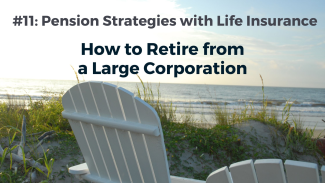
How to Retire from a Large Corporation #11: Pension Strategies with Life Insurance
Are you like many people we know in Harrisonburg and Rockingham County who are excited about their retirement years, but are overwhelmed by the complexity and all of the numbers in front of you? When should you draw Social Security? How much will healthcare cost? How much will you actually spend in retirement?
All these numbers are important and you should absolutely get a handle on them as you get closer to the date; but do not get overwhelmed with the complexity of the task. The goal is to stay focused on the big picture and break down your decisions into simple action items.
This blog is the 11th in a series, “How to Retire from a Large Corporation” and is designed to accompany an e-book by the same name.
Are you fortunate enough to have a pension from your company? If so, then you should celebrate, because your children will probably not have the luxury of a pension when they retire. The next few blogs in this series were written to equip you to make the very best decision for you and your family.
Before we dig in, here is an important disclaimer required by our back office: A plan participant leaving an employer typically has four options (and may engage in a combination of these options), each choice offering advantages and disadvantages.:
- Leave the money in his/her former employer’s plan, if permitted;
- Roll over the assets to his/her new employer’s plan, if one is available and rollovers are permitted;
- Take a lifetime annuity check from company plan, if applicable
- Roll over to an IRA; or
- Cash out the account value.
Your pension may be one of your largest retirement assets. If you are like most folks we know in Harrisonburg, VA, and around the Shenandoah Valley, the pension decision can be the most difficult to plan around. Options abound, opinions are abundant, and you do not want to make a mistake with a decision this important.
In our prior posts, we explored the difference between lump sum rollovers and life annuity options. We also dug deeper into “leveling” and “PLOP” Options. We also walked you through how to determine the internal rate of return (IRR) you would need to earn on a hypothetical investment based on various life expectancies, and how you make sure that you compare the lump sum and pension choices “apples to apples.”
In this post we explore a strategy that some people dub “Pension Maximization” using life insurance. While this strategy can make sense for some people, it can also be disastrous for others if not planned for wisely. It should only be considering in the context of a comprehensive financial plan.
Here’s an example of the concept: Let’s say the lifetime annuity amount with no survivor benefits from your company pension is $4,000 per month. You are married and also have the option of taking a reduced pension amount of $3,200 per month, but if you die before your spouse then your spouse will continue to receive $3,200 per month for his or her lifetime as well.
This decision can be extremently difficult and many folks have a hard time giving up $800 per month for the rest of their life for a survivor benefit that may never come to fruition. If the retiree dies prematurely the spouse is set financially, but if the retiree outlives their spouse, then this income reduction does not benefit anyone at all and is essentially wasted.
This is where the financial advisor or insurance person comes along and suggests a strategy often called “Pension Maximization.” The irony here is that often this strategy evaporates your pension if not used correctly.
Here is an example of how the concept works: The advisor says, “Go ahead and take the $4,000 per month “no survivor” option, but then purchase a life insurance policy for $600 per month. The net to you is still $3,400 per month, which is greater than the $3,200 per month with the 100% survivor option with the pension. Plus you have more flexibility, because the life insurance policy may build cash value that you can access later if your spouse dies before you. Or, if you live a long time, the life insurance benefit can be passed on to your kids.”
Sounds great, right? Not necessarily. Before even entertaining this strategy, consider the following words of caution:
- Don’t ignore taxes. Let’s say that in the above example your tax rate is 25%. This means that your $4,000 per month pension actually nets you only $3,000 per month, and the $3,200 per month pension actually nets you $2,400 per month. Since life insurance is paid for with after-tax dollars, the above statements made by the advisor are not entirely accurate.
- What about market risk? Is the surviving spouse compfortable with their entire retirement dependent on the stock and bond markets? What happens if the retiree dies at a young age and the life insurance proceeds are invested at a time when the economy is not performing well?
- What about inflation? Often times advisors who sell the life insurance do not properly account for inflation.
- Model out several different scenarios. This “Pension Maximization” strategy can work well if both spouses live a long time or if the spouse dies before the retiree, but it can be disastrous if the retiree dies early and the spouse lives a long time.
- The type of life insurance is extremely important. Term is inexpensive, but will likely not pay a benefit if the retiree dies “when they are supposed to” at life expectancy. As an alternative, permanent insurance can be very costly. If you explore this strategy, ensure the life insurance is still in place when you die!
As stated earlier, this strategy can be very complex and should only be implemented in the context of a comprehensive financial plan. If you have any doubt about this strategy at all, then you probably should ignore it. Please consult your financial advisor before acting on any of the information presented here.
Check back next time as we explore the many benefits of pension IRA rollovers. If you are fortunate enough to have a pension, then make the most of it!. To download the full “How to Retire from a Large Corporation” eBook you can find it here.
—-
This is the 11th of many blogs we are writing to help you finish strong in life. Much of the content is pulled from an eBook we wrote entitled “How to Retire from a Large Corporation.” Click here to download the document. If you would like to discuss any of these topics in more detail, you can schedule a time to talk through this link.

